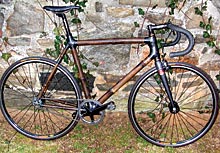Keith Young’s obsession with bicycles began at age 4, when he received one for his birthday. He was ill with mono at the time, and he stared at the gift for a month. Nearly three decades later, his enthusiasm for bikes hasn’t waned. To Young, they’re as normal a part of his life as choosing what to have for lunch. When he isn’t tinkering with his home-built bicycle or riding it during his day job as a courier, he’s thinking about bikes and bike design.

At 33, Young is fit and softspoken, with a neatly trimmed blond goatee and banged-up knuckles. His manner combines curiosity and shrewd determination. As a kid, he remembers dismantling his cycles and rebuilding them for fun. Since then, Young has dabbled with jobs at bike shops and for a time even raced bikes, but now considers them, above all, to be a practical mode of transportation.
While working on a violence-reduction project in Barrancabermeja, Colombia, several years ago, Young found daydreaming about bike design to be a welcome distraction from the grim reality around him. He considered the parts, methods and precise details required to build a bike from raw materials, making plans to get started when he returned to the States.
“Nearly the whole time in Colombia I figured I would build a carbon-fiber frame,” he recalls. That is, until he was dazzled by the widespread use of bamboo in South America: as food, as a construction material, as the beginnings of musical instruments, even as household plumbing. While the tropical grass is currently in vogue in the United States as green-building material, for centuries it has been a staple resource in the tropics, where bamboo is abundant, strong, renewable and relatively cheap.
So if bamboo can be used to build homes, Young reasoned, why not build a bike with it? One day while surfing the Web, he navigated to the site of Craig Calfee, a bamboo-bike builder based in California. “What he was making was really different and beautiful,” Young recalls. “I decided then that I was going to build a bamboo bike. And once I say I’m going to do something, I’m going to do it.”
But while he had proof that it was possible to build one, actually doing it was another problem altogether.
Calfee estimates there are fewer than a dozen bamboo frame-builders across the country, and his firm, Calfee Designs, is the only one that fabricates them commercially, selling about 100 per year. “I think bamboo [frames] will become more popular as more people try them out,” says Calfee, whose frames sell for nearly $3,000 a piece. “Bamboo has a super-smooth ride quality. It absorbs road vibration better than any other material. They don’t rust, corrode or rot if sealed properly, and they look wicked cool.” He adds, however, that they are harder to build than it might seem.
Even choosing the right stalk to work with is not easy. While it’s possible to grow the raw material in one’s own backyard, it’s tricky to establish the age of any given stalk, which is a crucial determinant of its strength. Young harvested the bamboo he used from a commercial grower in Georgia. As it dried in his apartment, he had plenty of time to figure out how to engineer a frame.

As it turns out, joining two pieces of bamboo is not unlike the conventional method of building a carbon-fiber frame. After precise cuts are made to them, segments of bamboo are wrapped together and joined with a sort of high-tech electrical tape and epoxy. Young gathered morsels of know-how from Calfee, as well as several books and a YouTube video, but he mainly learned the fledgling trade through trial and error.
Along the way, Young has become something of an expert on bamboo’s cultural minutiae (it’s the fastest growing plant in the world; it shelters a billion people worldwide; there are more than 1,000 bamboo species) and he’ll tell you a few things about frame-building, too.
This past January, he rolled his bamboo bike out of the shop for a trial run. While you might envision a mobile version of a dentist office’s inelegant furniture or one of the Professor’s crude bamboo contraptions on Gilligan’s Island, the truth is, Young’s 3.5-pound, fixed-gear bike is as sharp as any set of wheels you might see in a shop window. The bone-like contours of the dark-brown, earthy material are in stark contrast to the ultra-high-tech components made of titanium and other space-age alloys. That juxtaposition is the first clue that there’s something remarkable about the bike. And that’s what attracted Young to the idea in the first place.
One day he hopes to build his bikes commercially, but not until he tweaks the production line so he can build more for less—changes that might make the process more energy-efficient, as well. “A lot of people like bamboo because it’s greener, but I’m not sure I’ve done the environment any favor,” admits Young, in light of the energy required to create a single frame.
Despite its appearance in trendy home-furnishings catalogs, bamboo as a bike material remains a strange novelty. “A lot of people will come up to me and ask how I got the frame to look like bamboo,” says Young, who is at work on a second frame that he promises will be even better.
[Jack Igelman lives in Asheville.]




That is so neat!
I can’t wait till he makes them commercially, I would love to ride a bamboo bike! :)
I suppose the tape-epoxy joints are as strong as welded metal joints, but what sounds interesting is the bike’s ability to absorb road vibration. It makes sense. Bamboo seems like a strong material, but not too rigid.
Hi, this is Keith Young, the guy that made the bamboo bicycle frame featured in the article. My email address is: keiteryoung@hotmail.com in case you would like to contact me with comments or questions.
Hey, That is really awesome. I hope sometime in the close future I can try it. Come visit your brother and bring the bike to Kalamazoo. Great Job! Best wishes from MI. Zsuzsi Erdi